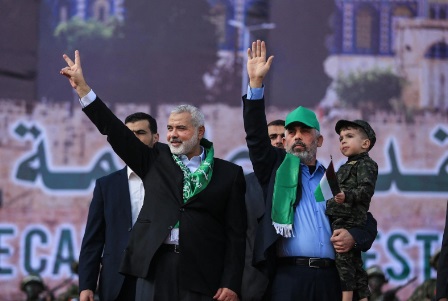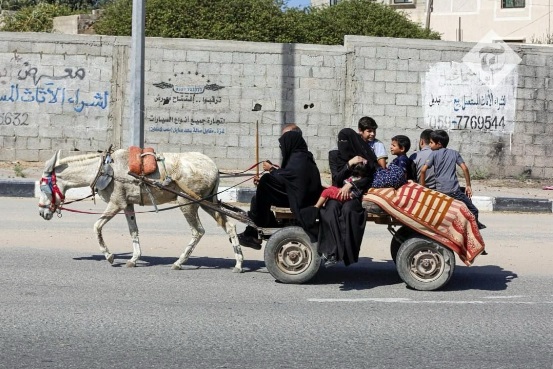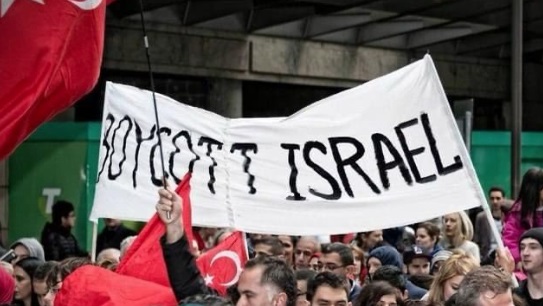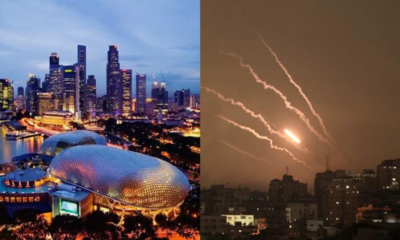Who is Hamas Blog
Who Considers Hamas a Terrorist Organization

Hamas leaders Ismail Haniyeh and Yahya Sinwar. Credit: ‘ישראל היום’ FB page.
Who Considers Hamas a Terrorist Organization
Hamas, an Islamist terrorist organization operating in the Palestinian territories, has garnered international attention for its acts of terror against Israel. This article aims to shed light on the widespread recognition of Hamas as a terrorist organization by Western countries and various international bodies.
Hamas’s Militant Actions and Global Response
Hamas Tractor and Palestinian civilians breaking the Israel-Gaza border. Credit: Oz Koren FB page.
Hamas, known for its governance over two million Palestinians in the Gaza Strip, has drawn condemnation for its military activities, with a significant attack in October 2023 grabbing headlines. The group launched a massive surprise attack on southern Israel, resulting in the tragic loss of over 1,400 lives and the taking of hundreds of hostages. In response, Israel declared war on Hamas, expressing its intent to eradicate the group entirely through a prolonged military operation.
International Designations of Terrorism
Dozens of countries, particularly in the West, have officially labeled Hamas as a terrorist organization. It is crucial to note that while some nations apply this designation broadly to the entire organization, others specifically target Hamas’s military wing. The distinction reflects the multifaceted nature of Hamas, which combines political and militant activities.
Iran’s Support and Turkey’s Shelter
Iran President Raisi and Turkey President Erdogan. Credit: Presidency of the Republic of Turkey FB page.
The complexity of international relations comes into play as Iran provides Hamas with both material and financial support. This support further complicates the global stance on Hamas, as it blurs the line between state-sponsored assistance and the independent actions of a militant group. Additionally, reports suggest that Turkey offers shelter to some of Hamas’s top leaders, raising concerns about the extent to which foreign nations are implicated in the group’s activities.
Fatah’s Contrast and the West Bank Dilemma
In the broader context of Palestinian politics, Hamas’s rival party, Fatah, which dominates the Palestine Liberation Organization (PLO) and governs in the West Bank, stands in stark contrast. Fatah has formally renounced violence, although adherence to this commitment has fluctuated during periods of heightened Israeli-Palestinian tensions. The split in Palestinian leadership, with Hamas maintaining its hostility towards Israel, further complicates efforts to achieve stability in the Gaza Strip.
International Consensus: The Organization of American States (OAS)
One notable coalition that has unequivocally designated Hamas as a terrorist organization is the Organization of American States (OAS). Comprising 35 countries in North and South America, the OAS issued a statement amid one of Israel’s worst episodes of conflict with Hamas. Luis Almagro, the OAS secretary-general from Uruguay, emphasized the unequivocal nature of Hamas’s terrorist aggression, describing it as unlimited and always seeking civilian victims. Almagro pointed out that the group’s actions aim to escalate conflict dynamics and sow terror among innocent populations, irrespective of their nationality.
In his statement, Almagro highlighted, “The recent attacks launched by Hamas against the Israeli civilian population undoubtedly constitute attacks of a terrorist nature.” This strong stance underscores the consensus within the OAS that Hamas’s tactics, specifically targeting civilians and sowing terror, align with the definition of terrorism.
Conclusion: A Global Challenge
The designation of Hamas as a terrorist organization is not confined to a particular region; it echoes globally. The recognition by Western countries, international organizations like the OAS, and the condemnation of Hamas’s actions collectively emphasize the urgent need for a comprehensive and coordinated response to address the complex challenges posed by this militant terrorist group. As the world grapples with the implications of Hamas’s actions, fostering awareness about its terrorist nature becomes a crucial step towards promoting international cooperation in addressing this ongoing crisis.
Who is Hamas Blog
What do Gaza citizens think about Hamas?

Citizens of Gaza on a funeral. Credit: Yossi Davidov’s FB page.
In the complex geopolitical landscape of the Middle East, the Gaza Strip stands out as a region of intense focus, particularly regarding its control by Hamas. Since its inception, Hamas has been a polarizing force, eliciting varied responses from the international community and, crucially, from the citizens of Gaza themselves. This article delves into the nuanced and evolving perceptions of Gazans towards Hamas, exploring the group’s ascension to power, the changing attitudes of the Gazan populace before the massacre on Israeli civilians on October 7th, 2023, and the significant impact of Israel’s recent military responses on the Gazans, and their perceptions of Hamas. By examining these facets, we aim to provide a deeper understanding of the sentiments held by Gazans towards Hamas, a key player in the region’s intricate political and social fabric.
Citizens of Gaza on a funeral. Credit: Yossi Davidov’s FB page.
How Hamas Gained Leadership Over Gaza
Hamas, an Islamic terror group, has been ruling Gaza since 2007. This leadership was established through a combination of political maneuvering and force, notably after the triumph of Fatah in the last Palestinian parliamentary election in 2006. Hamas took the power from Fatah in a civil war.
Gazans’ Views of Hamas Before October 7th
Before the critical events of October 7th 2023, the views of Gazans towards Hamas were marked by growing dissatisfaction and despair, shaped by dire living conditions and a lack of political change. In 2018, amidst a backdrop of severe healthcare crises where 25% of women in Gaza faced life-threatening risks during childbirth and 53% of the population lived in poverty, the dissatisfaction with Hamas’ governance was palpable. Another study which was done, highlighted that nearly half of the Gazans wished to leave the strip entirely, reflecting a deep-seated sense of hopelessness.
In a more recent 2023 poll by the Washington Institute, a significant 64% of Gazans prioritized demands for improved healthcare, employment, education, and a semblance of normalcy, starkly contrasting with Hamas’ focus on “resistance.” This sentiment was further underscored by an overwhelming 92% expressing outright frustration with their living conditions.
Moreover, a striking 73% of Gazans perceived the Hamas government as corrupt. With no elections held since 2006, a substantial portion of the Gazan population, having never voted for Hamas, saw little prospect for electoral change.
Reflecting on the past, when Hamas seized control over the Gaza Strip in 2007 after openly confronting the Palestinian Authority, over 73% of Palestinians, including Gazans, opposed the seizure and further armed conflict. At that time, support for military action against Israel was minimal among Gazans, with fewer than one-third endorsing such actions. Over 80% condemned acts of kidnapping, arson, and indiscriminate violence, highlighting a prevailing desire for peace and stability over armed resistance.
Impact of Israel’s Response to the 7th of October attack on Gazans’ views
The situation changed dramatically following the October 7, 2023 terror attack by Hamas on Israel and the subsequent Israeli military response. This response, involving significant bombardment, led to the destruction of homes and infrastructures, led to exacerbating the plight of Gazans. Many, including those who neither supported nor were members of Hamas, suffered greatly from these much-anticipated responses .
Conclusion: A Complex Dynamic
The current dynamics in Gaza highlight a complex and tragic situation. While the people of Gaza have long been critical of Hamas’ rule and have suffered under its governance, the Hamas terror attacks and actions have further complicated the situation, despite Hamas statements about their actions intended to protect the Palestinians and liberate them.
Who is Hamas Blog
Do Hamas leaders actually live in the Gaza Strip?

Hamas leaders on a private jet. Credit: Uzair Khattak’s FB page.
A common question that arises in discussions about Hamas and its leadership is the actual residence of its leaders. Contrary to what some might assume, many senior figures of Hamas, a group designated as a terrorist organization by several countries, do not reside in the Gaza Strip. This article delves into the current living arrangements of Hamas leaders, their historical journey to power, and the ascension of Ismail Haniyeh to the group’s leadership.
Where Are Hamas Leaders Living These Days?
Doha, Qatar’s skyline. Credit: ‘Hello Qatar’ FB page.
Senior leaders of Hamas, including Ismail Haniyeh, enjoy comfortable lives in countries like Iran, Qatar, Lebanon, and Turkey. In stark contrast to the dire situation in Gaza, these leaders live in luxurious conditions, far removed from the war and hardship. They manage significant operations from their foreign residences, including directing terrorist activities and engaging in international relations. This disparity highlights a significant gap between the experiences of the Hamas leadership and the everyday realities faced by the people of Gaza and that in fact, the lives of the people in Gaza and improving them, is not really part of their own financial equation.
The History of Hamas Leaders
The leadership of Hamas includes influential figures such as Ismail Haniyeh, Khaled Mashal, Mousa Abu Marzook, and Saleh al-Arouri, each with a distinct history within the organization. Ismail Haniyeh, after Hamas’ electoral victory in 2006, rose to leadership and was appointed as the Prime Minister of the Palestinian Authority in the Gaza Strip. Saleh al-Arouri became involved in Hamas leadership after his release from Israeli prison in 2010, establishing the Judea and Samaria headquarters. Khaled Mashal and Mousa Abu Marzook have also played vital roles in the organization’s international strategies and policies.
Who Is Leading Hamas These Days?
The current senior figures in Hamas’ foreign leadership include Khaled Mashal, Mousa Abu Marzook, Ismail Haniyeh, and Saleh al-Arouri, among others. These individuals are instrumental in orchestrating Hamas’ international strategies and maintaining its terrorist activities across various countries.
The Rise of Ismail Haniyeh
Ismail Haniyeh. Credit: Inbar Cohen’s FB page.
Ismail Haniyeh’s journey to the helm of Hamas’ leadership is a story of political ascent and increasing influence. Before Hamas‘ electoral victory in 2006, Haniyeh was not a prominent member of the group. Post-election, he rose to prominence, eventually being appointed as the Prime Minister of the Palestinian Authority in the Gaza Strip. His wealth grew substantially during his tenure, partly due to the control exerted over the Gazan economy and taxation policies.
Haniyeh’s Lifestyle and Controversies
Haniyeh, despite his position, leads a life of comfort in Qatar, far removed from the hardships faced by the residents of Gaza. This has drawn criticism from many, including Palestinians. His family, too, enjoys significant privileges and freedoms not available to ordinary Gazans. Reports suggest that Haniyeh’s wealth has allowed him to invest in various properties in Gaza and abroad.
Conclusion
The dichotomy between the living conditions of Hamas leaders and the people of Gaza is stark. While leaders like Haniyeh live in luxury abroad, the residents of Gaza face significant hardships. This disparity raises questions about the leadership’s connection to the realities on the ground and how much the lives of their own civilians really play any part in their offensive decisions.
Who is Hamas Blog
What is the difference between BDS, Hamas, and Hezbollah

BDS protest. Credit: YNET’s FB page.
The Middle Eastern conflict, particularly the Israeli-Palestinian issue, has been marked by the involvement of various organizations with different ideologies and methods. Among these are the Boycott, Divestment, and Sanctions (BDS) movement, Hamas, and Hezbollah. Understanding their origins, objectives, differences, sponsors, and impact is crucial for comprehending the complexities of the conflict.
History and Origins of BDS, Hamas and Hezbollah
BDS: The roots of the BDS movement can be traced back to the NGO Forum at the 2001 World Conference Against Racism in South Africa (Durban I). Here, Palestinian activists collaborated with anti-apartheid veterans, drawing parallels between Israeli policies and apartheid in South Africa. The forum’s declaration, which highlighted Israel as an apartheid state and called for comprehensive sanctions, laid the groundwork for the BDS movement. In 2002, Palestinian scholars, responding to the Israeli army’s re-entering Palestinian territories, called for global civil society’s support in suspending economic relations with Israel. This period also saw initiatives like the Rose’s Academic Boycott call, gathering significant support from academics globally, setting a precedent for the formal establishment of the BDS movement in 2005.
Hamas: Established in 1987, Hamas emerged from the Muslim Brotherhood and religious factions of the PLO (Palestine Liberation Organization) during the first Palestinian Intifada. Hamas has become actively involved in the Israeli-Palestinian issue, in 1990’s, using the first suicide bombings against civilian targets.
Hezbollah: Hezbollah, established in the aftermath of the 1982 Lebanon War, was founded by Lebanese clerics who had studied in Najaf. Influenced by Ayatollah Khomeini’s model post-Iranian Revolution, Hezbollah’s formation involved around 1,500 instructors from Iran’s Islamic Revolutionary Guard Corps. It unified various Lebanese Shia groups to resist Israeli occupation in Southern Lebanon. The 1985 Hezbollah manifesto clearly stated its goal of expelling foreign influences from Lebanon and ending any colonialist presence. Active in conflicts such as the 1985–2000 South Lebanon conflict and the 2006 Lebanon War, Hezbollah also contributed volunteers to the Bosnian War in the 1990s, demonstrating its regional influence beyond Lebanon.
Goals and Objectives
BDS Protests in Ben Gurion Airport. Credit: Yediot Aharonot FB page.
BDS: BDS seeks to pressure Israel into compliance with international law, focusing on the withdrawal from occupied territories, removing the separation barrier, ensuring equality for Arab-Palestinian citizens of Israel, and upholding the rights of Palestinian refugees.
Hamas: Hamas aims to establish an Islamic state in what they refer to as historical Palestine, using violent means, including terrorism, to achieve its objectives.
Hezbollah: Hezbollah’s initial objectives, as outlined in its 1985 manifesto, were focused on expelling foreign forces, including Americans, French, and their allies, from Lebanon and ending colonialist entities on Lebanese soil. This objective was coupled with a broader goal of resisting the Israeli occupation of Southern Lebanon. Over time, while continuing to emphasize resistance against Israel.
Differences Between the Organizations
BDS is a political movement promoting boycotts, divestment, and sanctions, while Hamas and Hezbollah are terrorist groups engaging in direct conflict.
Hamas focuses on Palestinian nationalism and Islamism in the West Bank and Gaza, whereas Hezbollah has a broader regional influence, rooted in Lebanon, and aligned with Iran.
BDS primarily targets international law and human rights violations, in contrast to the broader political and religious goals of Hamas and Hezbollah.
Sponsors and Support
BDS: The movement is supported by a wide range of organizations and groups globally, including Palestinian NGOs, international student organizations, and activist groups.
Hamas: Funded by countries like Iran and Qatar, Hamas also relies on various methods, including crypto currencies, to bypass sanctions.
Hezbollah: Iran is the primary backer of Hezbollah, providing substantial financial and logistical support.
Impact on the Israeli-Palestinian Conflict
Each organization has significantly influenced the conflict:
BDS impacts international opinion and policy towards Israel through its advocacy and campaigns.
Hamas has been directly involved in conflicts with Israel, including rocket attacks and suicide bombings and was the planner and executer of the massacre of 7th in October 2023.
Hezbollah has engaged in armed confrontations with Israel, notably the 2006 Lebanon War, and has become a prominent political and military force in Lebanon.
Conclusion
In summary, while BDS, Hamas, and Hezbollah are often mentioned in the context of the Israeli-Palestinian conflict, they represent distinct paradigms. BDS advocates for non-violent resistance and adherence to international law, Hamas seeks an Islamic state through armed struggle, and Hezbollah, initially a militia against Israel, has evolved into a significant political and militant force with broader regional implications. Understanding these differences is essential for anyone looking to grasp the nuances of the Middle Eastern conflict.
-

 News2 months ago
News2 months agoGaza could Have Been Singapore. Hamas Turned It Into a living nightmare
-

 News2 months ago
News2 months agoRape, slaughter, and atrocities—see the real face of Hamas
-

 News2 months ago
News2 months agoKidnapping elderly and children: Hamas are no heroes
-

 Hamas War Strategy, Tactics, and PR2 months ago
Hamas War Strategy, Tactics, and PR2 months agoThe War Crimes of Hamas and ISIS in Exploiting Civilians
-

 News2 months ago
News2 months agoMonsters: Yahya Sinwar and Hamas kidnapped 150+ children and women.
-

 News2 months ago
News2 months agoTrigger warning: This is the atrocity that’s happening in Israel right now
-

 News2 months ago
News2 months agoShe died while saving lives.
-

 News2 months ago
News2 months agoHamas turns a music festival into a massacre






